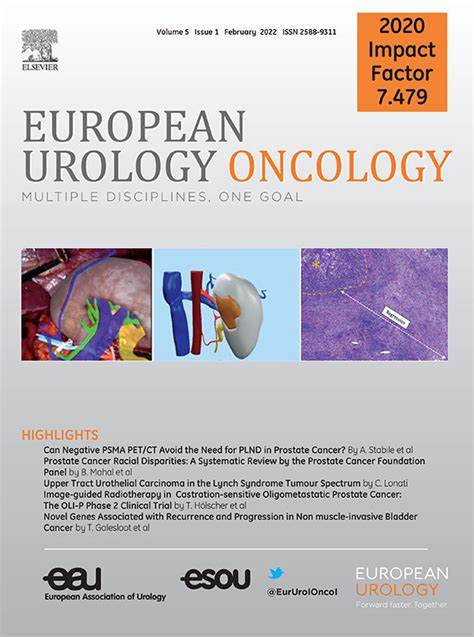Towards Defining Follow-up Strategies for Patients with Primary Intermediate-risk Non–muscle-invasive Bladder Cancer
IF 9.3
1区 医学
Q1 ONCOLOGY
引用次数: 0
Abstract
Background and objective
The current European Association of Urology (EAU) guidelines on non–muscle-invasive bladder cancer (NMIBC) categorize patients into four risk groups. In 2024, a specific follow-up schedule was introduced for intermediate-risk (IR) disease. However, recommendations are based on expert opinion and restricted to patients with IR-NMIBC who have primary low-grade or high-grade/grade 2 disease. Our aim was to identify a subgroup of patients with IR-NMIBC who may require more stringent follow-up.
Methods
We conducted a retrospective analysis of 2086 patients with IR-NMIBC classified according to the World Health Organization 1973 grading scheme. Multivariable Cox-regression models were fitted to identify predictors of recurrence, which were then used to dichotomize groups with low risk of recurrence (IR-Low) versus high risk of recurrence (IR-High). Kaplan-Meier curves were plotted to estimate recurrence-free survival (RFS) and progression-free survival (PFS). Smoothed hazard estimates of first recurrence were plotted by risk group.
Key findings and limitations
Multifocality and tumor size ≥3 cm were significantly associated with higher risk of first recurrence and were used to define the IR-High and IR-Low (unifocal, size <3 cm; n = 1087) groups. The 3-yr RFS rate was significantly worse for the IR-High group (51%, 95% confidence interval [CI] 48–54%) than for IR-Low (68%, 95% CI 65–71%). The risk of progression was low (5-yr PFS rate 96%) with no significant difference between the IR-High and IR-Low groups.
Conclusions and clinical implications
During IR-NMIBC follow-up for recurrence, tumor size and focality should be considered rather than grade. If the primary objective is to ensure prompt detection of recurrence, follow-up schedules should be tailored according to the risk of recurrence, with more stringent protocols for patients with IR-NMIBC at higher risk of recurrence.
确定原发性中危非肌浸润性膀胱癌患者的随访策略。
背景和目的:目前欧洲泌尿外科协会(EAU)关于非肌肉浸润性膀胱癌(NMIBC)的指南将患者分为四个危险组。2024年,引入了针对中等风险(IR)疾病的特定随访计划。然而,建议是基于专家意见,并且仅限于原发性低级别或高级别/ 2级疾病的IR-NMIBC患者。我们的目的是确定一个可能需要更严格随访的IR-NMIBC患者亚组。方法:我们对2086例按照世界卫生组织1973年分级方案分类的IR-NMIBC患者进行回顾性分析。拟合多变量cox回归模型以确定复发的预测因子,然后将复发风险低(IR-Low)和复发风险高(IR-High)分组。绘制Kaplan-Meier曲线来估计无复发生存期(RFS)和无进展生存期(PFS)。按风险组绘制首次复发的平滑风险估计值。主要发现和局限性:多灶性和肿瘤大小≥3 cm与首次复发的高风险显著相关,并用于定义IR-High和IR-Low(单灶性,大小)结论和临床意义:在IR-NMIBC随访复发时,应考虑肿瘤大小和灶性,而不是分级。如果主要目的是确保及时发现复发,则应根据复发风险量身定制随访计划,对于复发风险较高的IR-NMIBC患者,应采用更严格的方案。
本文章由计算机程序翻译,如有差异,请以英文原文为准。
求助全文
约1分钟内获得全文
求助全文
来源期刊

European urology oncology
Multiple-
CiteScore
15.50
自引率
2.40%
发文量
128
审稿时长
20 days
期刊介绍:
Journal Name: European Urology Oncology
Affiliation: Official Journal of the European Association of Urology
Focus:
First official publication of the EAU fully devoted to the study of genitourinary malignancies
Aims to deliver high-quality research
Content:
Includes original articles, opinion piece editorials, and invited reviews
Covers clinical, basic, and translational research
Publication Frequency: Six times a year in electronic format
 求助内容:
求助内容: 应助结果提醒方式:
应助结果提醒方式:


